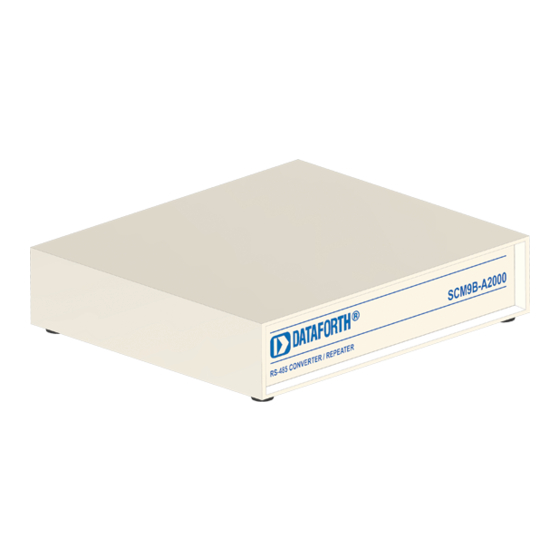Dataforth SCM9B-A1000 Series User Manual - Page 6
Browse online or download pdf User Manual for Media Converter Dataforth SCM9B-A1000 Series. Dataforth SCM9B-A1000 Series 8 pages. Converter boxes

SCM9B-A1000 & SCM9B-A2000 USERS MANUAL 6
BAUD RATE
The SCM9B-A1000 and SCM9B-A2000 series converters each contain a
10-position DIP switch located on the rear panel. The DIP switch is used
to select the correct communications baud rate and must be set to the
same value as the devices connected to the RS-485 OUT connector.
Only one baud rate switch may be turned on at one time.
L E D S
The SCM9B-A1000 contains three status LEDs labelled FAULT,
POWER and TRANSMIT located on the converter front panel. The
SCM9B-A2000 contains two status LEDs labelled PWR and TX located
on the converter rear panel. The status indicators are useful while
troubleshooting suspected system faults and provide visual status
indication during normal system operation.
The SCM9B-A2000 converter LEDs may be disabled internally. Low
power applications, typically powered by batteries or solar panels, can
benefit significantly by disabling the status LEDs. The SCM9B-A2000
power consumption may be reduced by up to 50% with the LEDs
disabled. To disable the status LEDs, remove the SCM9B-A2000 top
cover and locate the 3-pin strip on the PC board directly behind the
LEDs. Lift the jumper bar from the pin strip and place it over the two pins
located closest to 'LEDS OFF' written on the PC board.
The POWER (SCM9B-A1000) and PWR (SCM9B-A2000) LEDs are pilot
lights that indicate adequate power supply voltage is applied to the
converter.
The TRANSMIT (SCM9B-A1000)
and TX (SCM9B-A2000)
LEDs
illuminate as data is transmitted from a host computer onto the RS-485
communications bus. The illumination intensity will vary and may become
hard to detect as the baud rate increases.
The SCM9B-A1000 FAULT LED will illuminate if excessive current is
being drawn from the internal +24Vdc one amp power supply.
RS-485 TERMINATIONS
The proper termination techniques for any RS-485 system require two
biasing resistors and two termination resistors. There must be one pull-up
resistor between the DATA+ line and +5Vdc on each RS-485 network.
There should also be a pull-down resistor from the DATA- line to ground.
These two resistors are the biasing resistors and are normally positioned
at the HOST end of the cable. The RS-485 standard also requires two
resistors across the data lines for proper termination. Two 220 Ω resistors
should be placed across the data lines DATA+ and DATA-. The resistors
